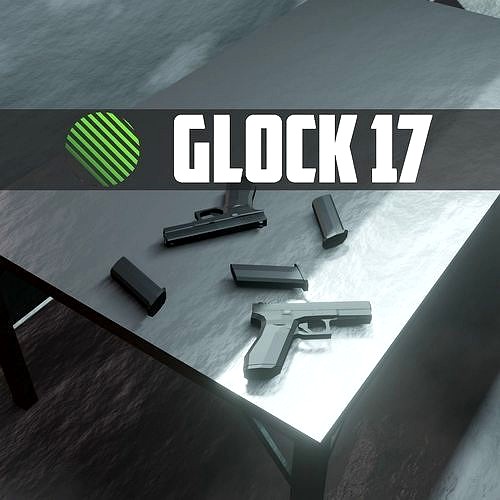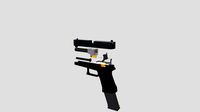CG Trader

glock 17 low poly
by CG Trader
Last crawled date: 1 year, 10 months ago
In 1980, the Austrian Armed Forces announced that it would seek tenders for a new, modern duty pistol to replace their World War II–era Walther P38 handguns. The Federal Ministry of Defence of Austria formulated a list of 17 criteria for the new generation service pistol, including requirements that it would be self loading; fire the NATO-standard 9×19 mm Parabellum round; the magazines were not to require any means of assistance for loading; be secure against accidental discharge from shock, strike, and drop from a height of 2 m onto a steel plate. After firing 15,000 rounds of standard ammunition, the pistol was to be inspected for wear. The pistol was to then be used to fire an overpressure test cartridge generating 5,000 bar (500 MPa; 73,000 psi). The normal maximum operating pressure (Pmax) for the 9mm NATO is 2,520 bar (252 MPa; 36,500 psi). Glock became aware of the Austrian Army's planned procurement, and in 1982 assembled a team of Europe's leading handgun experts from military, police, and civilian sport-shooting circles to define the most desirable characteristics in a combat pistol. Within three months, Glock developed a working prototype that combined proven mechanisms and traits from previous pistol designs. In addition, the plan was to make extensive use of synthetic materials and modern manufacturing technologies, which led to the Glock 17 becoming a cost-effective candidate. Several samples of the 9×19mm Glock 17 (so named because it was the 17th patent procured by the company) were submitted for assessment trials in early 1982, and after passing all of the exhaustive endurance and abuse tests, the Glock emerged as the winner. The handgun was adopted into service with the Austrian military and police forces in 1982 as the P80 (Pistole 80), with an initial order for 25,000 guns. The Glock 17 outperformed eight different pistols from five other established manufacturers (Heckler & Koch of Germany offered their P7M8, P7M13, and P9S, SIG Sauer of Switzerland bid with their P220 and P226 models, Beretta of Italy submitted their model 92SB-F, FN Herstal of Belgium proposed an updated variant of the Browning Hi-Power, and the Austrian Steyr Mannlicher entered the competition with the GB). The results of the Austrian trials sparked a wave of interest in Western Europe and overseas, particularly in the United States, where a similar effort to select a service-wide replacement for the M1911 had been going on since the late 1970s (known as the Joint Service Small Arms Program). In late 1983, the United States Department of Defense inquired about the Glock pistol and received four samples of the Glock 17 for unofficial evaluation. Glock was then invited to participate in the XM9 Personal Defense Pistol Trials, but declined because the DOD specifications would require extensive retooling of production equipment and providing 35 test samples in an unrealistic time frame. After joint Norwegian and Swedish trials in 1983–1985, in 1985 the Glock 17 was accepted into service as the P80 in Norway, and in 1988 as the Pistol 88 in Sweden, where it surpassed all prior NATO durability standards. As a result, the Glock 17 became a standard NATO-classified sidearm and was granted a NATO Stock Number (1005-25-133-6775). By 1992, some 350,000 pistols had been sold in more than 45 countries, including 250,000 in the United States alone. Starting in 2013, the British Armed Forces began replacing the Browning Hi-Power pistol with the Glock 17 Gen 4, due to concerns about weight and the external safety of the Hi-Power. The British preferred the Glock 17 Gen 4 over the Beretta Px4 Storm, FN FNP, Heckler & Koch P30, SIG Sauer P226, Smith & Wesson M&P, and Steyr M9A1 of which 19 pistols each, all chambered in 9×19mm Parabellum, were entered in the R9GSP trials. The French Armed Forces (FAF) in 2020 began replacing their MAC Mle 1950 and to a lesser extent their PAMAS G1 pistols with Glock 17 Gen 5 models specifically made for the FAF. The French preferred the Glock 17 Gen 5 over the HS2000 and CZ P-10 offerings that also made it to the final selection phase. * The currently version is a GLOCK 17 gen5 * Including black texture. Available too on this pack : https://www.cgtrader.com/3d-models/military/gun/french-special-forces-weapons-operator-low-poly-pack Available FORMATS: OBJ(mesh only) DAE(mesh and materials) FBX(mesh and materials) BLEND(mesh and materials) GLTF(mesh only) ABC(mesh) ENJOY glock 17 gen5 gen4 9mm pistol colt french army special force police gun semi automatic rifle combat m4 ak light military
Similar models
3d_export
free

Glock 18
...istol manufactured by glock gmbh with a caliber of 9×19 mm parabellum. designed for arming special forces of the army and police.
cg_trader
$200

Low Poly glock
...in reliability and safety tests glock gun low lowpoly militart police army handgun sidearm game devolopment asset roblox military
3dwarehouse
free

Glock semi or Full automatic Pistol , Austria
...es.m.b.h. it entered austrian military and police service by 1982 after it was the top performer in reliability and safety tests.
cg_trader
$10

glock gun
...e best selling pistol on gunbroker. glock gun weapon bullet army war protection police rifle silhouette security trigger military
cg_trader
$4

Glock 17
...seperated in 4 parts : body slide trigger magazine gun pistol security police weapon bullet ammo firearm army glock military prop
cg_trader
$15

Glock 17 Gen 4 UNTEXTURED
...e, magazine, ect.) most of the faces are because of the 17 bullets glock weapon gun pistol firearm handgun semi magazine military
3dwarehouse
free

Glock 17
... on the z-axis (the width of the barrel) is not entirely accurate, but i liked it this way. #handgun #modern #pistol #war #weapon
cg_trader
$15

Sig Sauer P226 9mm Handgun
...sig sauer p226 9mm handgun
cg trader
game ready model of a sig sauer p226 handgun in 9x19
cg_trader
$10

Glock 17 Gen 3
...mat textures size (4096x4096) glock weapon pistol gun firearm handgun 17 magazine military army austria bullet 9mm ammo automatic
3dwarehouse
free

SIG-Sauer P226
... as jtf2 and the navy seals. #army #bullet #casing #clip #communism #gun #magazine #nuke #paradox #pistol #rifle #scope #sigsauer
Glock
3d_export
free

Glock
...glock
3dexport
glock 17
3d_export
$20

Glock 17c
...glock 17c
3dexport
glock 17c
turbosquid
$10

Glock
...id
royalty free 3d model glock for download as fbx and blend on turbosquid: 3d models for games, architecture, videos. (1391982)
3d_export
$5

Lowpoly glock
...lowpoly glock
3dexport
this is gameready lowpoly model of glock
3d_export
$5

Glock
...glock
3dexport
a relatively common pistol
turbosquid
$30

Glock
... available on turbo squid, the world's leading provider of digital 3d models for visualization, films, television, and games.
turbosquid
$20

Glock
... available on turbo squid, the world's leading provider of digital 3d models for visualization, films, television, and games.
turbosquid
$15

Glock
... available on turbo squid, the world's leading provider of digital 3d models for visualization, films, television, and games.
turbosquid
$1

Glock
... available on turbo squid, the world's leading provider of digital 3d models for visualization, films, television, and games.
3d_ocean
$12

Glock 17
... shoot war weapon
game-ready glock 17 gun ready for fps games. with pbr textures including: albedo(diffuse) specular gloss normal
17
3d_export
$6

rocks 17
...rocks 17
3dexport
rocks 3d model 17
3ddd
$1

PLANTS 17
...plants 17
3ddd
цветок , горшок
plants 17,, pots in diameter 100,80,60,40cm,,, enjoy
3d_export
$6

tap-17
...tap-17
3dexport
3d_export
$6

set-17
...set-17
3dexport
3d_export
$27

C-17 Globemaster
...c-17 globemaster
3dexport
c-17 globemaster
3ddd
free

Renault FT-17
...renault ft-17
3ddd
ft-17 , renault , танк
turbosquid
$40

cottage 17
...bosquid
royalty free 3d model cottage 17 for download as max on turbosquid: 3d models for games, architecture, videos. (1377003)
turbosquid
$30

Apartment 17
...squid
royalty free 3d model apartment 17 for download as max on turbosquid: 3d models for games, architecture, videos. (1432680)
turbosquid
$10

Surfboard 17
...squid
royalty free 3d model surfboard 17 for download as max on turbosquid: 3d models for games, architecture, videos. (1375686)
turbosquid
$7

Rock 17
...turbosquid
royalty free 3d model rock 17 for download as obj on turbosquid: 3d models for games, architecture, videos. (1486522)
